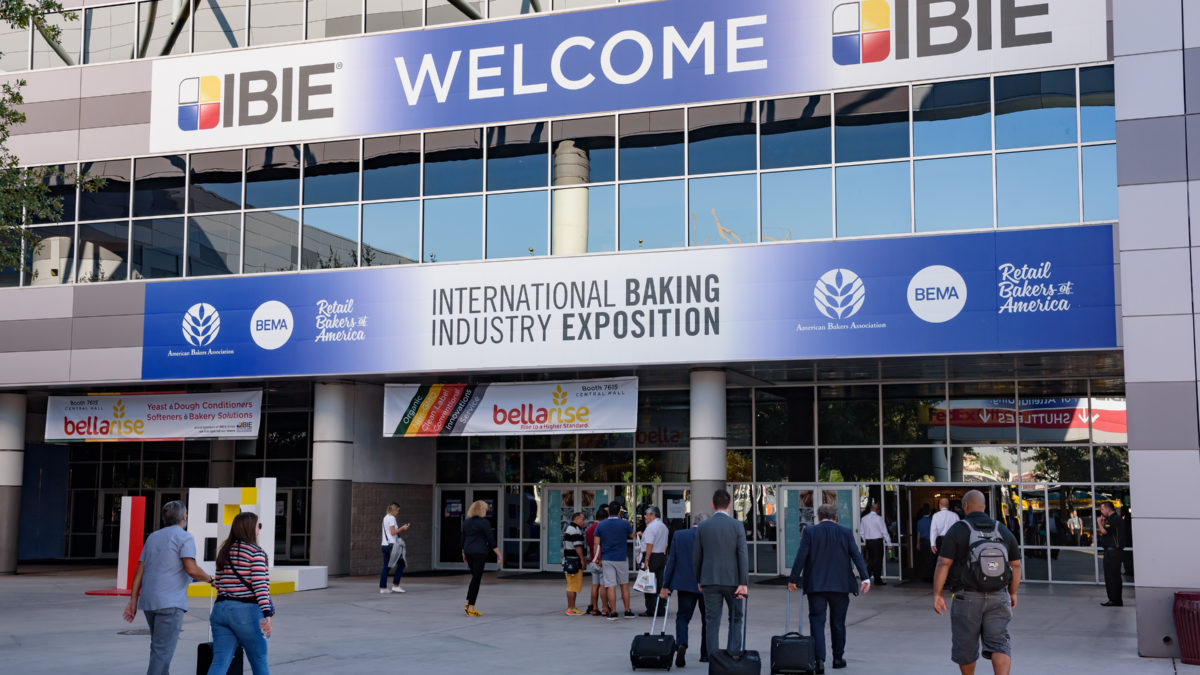Industry professionals learned secrets to setting up a controlled and balanced baking process during a 2019 International Baking Industry Exposition (IBIE) education session at the Las Vegas Convention Center.
Louis V. Nelson III, a process engineer within the Snacks group at the Kellogg Company, said in many bakeries there’s a tendency to use baking profiles that are imbalanced and unsustainable.
“They can create hazards for our personnel and they can cost our companies a lot of money with inefficient energy use and the production of inconsistent or low-quality food,” he explained, adding that “Sometimes the impact of that is not always tangible. But if you sell a box of crackers that are subpar the person won’t repeat the buy.”
“And that costs our companies money,” Nelson said. “Oftentimes these inconsistent processes are caused by a lack of understanding about how the ovens work or what the finished product is actually telling you about what you need to change on the baking profile.”
Nelson said while it makes sense to build a process that works and stick with it, that’s not the mindset of many oven operators.
Consistent Process Reduces Downtime
“They’re constantly trying to change the process when really you want your process to just be steady, immovable. You only want to change it when it’s absolutely necessary,” he said.
To demonstrate the principle, Nelson gave a quick primer on ribbon burner ovens.
“A ribbon burner oven consists of thousands of components that must work together harmoniously in order to produce consistent food,” he said.
Ribbon burner ovens operate via combustion that creates heat. One of the components of combustion is water, which he said people don’t think about. Heat is controlled independently in the top and bottom of each baking zone. So if you have a seven-zone oven, you have 14 zones to control because you’re controlling each section of that zone on the top and bottom.
Nelson pulled up schematics to show all the parts of the oven and points of control from combustion controls to exhaust vents.
“Simply put, a continuous baking process is out of balance if the inputs and outputs are not properly controlled resulting in an excess accumulation/discharge of each,” he said.
Consequences of Unbalanced Inputs and Outputs
The three primary input/output parameters are food, burners, and exhaust. Nelson said these parameters have an interdependent relationship and must be understood and balanced.
The inputs are moist food (dough), heat (created by the combustion of natural gas and air) and the ingress of fresh air to the process.
The outputs are the finished food, evaporative moisture, heat and combustion products (CO², NO², SO² and H²O).
So, what happens if these inputs/outputs accumulate within the baking environment?
“With food, it’s simple, if it accumulates in your oven, you know there’s going to be a fire,” Nelson explained. “If it doesn’t remain in your oven long enough, you’re going to have a soggy product. That’s easily understood, but balancing heat and exhaust is not always understood.”
To demonstrate the consequences of out-of-balance inputs and outputs, Nelson gave an overview of the cracker baking process. In general, the process can be broken down into three phases.
In Phase I, you’ll find the initial heating of the product and expansion due to leavening agents.
In Phase II, moisture migrates through the product, and evaporation leaves voids that solidify forming the cracker structure There’s an additional increase in volume and then crust formation.
Phase III is usually your finishing. The small amounts of remaining moisture are removed to achieve moisture targets, and finishing touches on color occur.
To achieve those targets, the oven settings vary for each phase with the top heat low or non existent and the bottom heat medium to high and the exhaust choked, but never closed during Phase I.
The Importance of Controlled Exhaust
Nelson said no matter where you are in the process you should always have a slight vacuum of exhaust released from the oven because you don’t want any of the products of combustion to come out into the baking environment where personnel are. But aside from that, you tend to choke down the exhaust to keep the moisture in the product. Keeping the product moist in this phase inhibits case hardening or top crusting. Preventing that means when you get further into your process that surface is still pliable to where it can easily release moisture.
Choking down too much can result in a baking chamber that is so pressurized that when the oven door is opened a constant flow of steam escapes.
“If those gases that are produced can’t go out through the exhaust, they’ve got to go somewhere,” Nelson cautioned. “And what they end up doing, since we usually run our ovens with the doors closed, is start going through all the cracks and crevices of the oven. It wets your insulation and starts to rust and corrode your oven over time.
“We’ve seen instances that have significantly damaged the oven to where it you just have to rebuild the oven completely,” Nelson said.
Occasionally, in Phase I, operators will have too much heat in combination with a choked off exhaust. Additional heat on top case hardens the product, giving it that top crust. Then, once you get into the next phase, where your product may be hot enough to release moisture, the moisture has a hard time escaping the product because it’s got that case hardening on it. Too much top heat in Phase I can also lead to blistering, and product with high moisture and low volume, and it can lead to operators making profile mistakes in Phase II and Phase III because they don’t realize the problem started in Phase I.
Phase II, where moisture evaporation and structure formation are the targets, the top heat will be set to medium or high. The bottom heat will be medium to high, and you need to set the exhaust higher to allow moisture to evaporate from the baking chamber. When a product arrives to Phase II already case hardened, many operators will make the problem worse by applying a ton of heat and choking down exhaust to try to get the heat up high enough to remove the moisture.
“But they’re actually making the problem worse, case hardening it even more,” Nelson said.
The oven may be hot enough to remove moisture, but with choked exhaust and saturated air, the moisture has nowhere to go, and it can turn your oven into a hot sauna.
“The product is going through your oven, it’s ready to release moisture, but the air is saying, ‘I cannot accept it.’ So the product has to wait until it gets into a space that has an environment to receive that moisture, and sometimes that doesn’t happen until Phase III.
Then Phase III is a mixed bag. If you have a lot of burners on, with a lot of heat, and more products of combustion, more exhaust is needed. But if you’re only using a few burners, don’t overdo the exhaust.
“Some believe that you have to max out your exhaust in Phase III and that the suction of the exhaust draws the moisture out of the food, and that’s not true,” Nelson said.
Much of the moisture needs to be gone before Phase III, or the ability to do fine touches in color is lost.
“And if you’re over exhausting in Phase III, you’re just wasting energy,” Nelson said.
One solution Nelson discussed for improving the baking process was steam injection added to Phase I. He cautioned against using too much, saying just enough intentional steam in the first phase can prevent case hardening and result in crackers with less blistering.
Every Step Builds Upon Itself
He also pointed out that everything can’t be blamed on the oven. You need to look at the ingredients, mixing, sheeting and then the baking process. Every step builds upon itself. If you have a bad mix, you’re going to have a bad dough, bad sheeting, bad bake, and bad product.
“One thing I always tell people is that you have garbage in, garbage out,” Nelson said. “If you have a bad dough, your oven can not fix a bad dough.”
He cautioned against knee-jerk reactions to fix bad dough. If you have a bad dough, and your cracker line is moving swiftly with 15-minute batch run times, and it takes 20 to 30 minutes to reset the oven, that bad dough is going to be gone before you can fix the problem.
“You end up chasing your tail trying to react to the doughs coming through, and it ends up becoming a cycle,” Nelson said.
But if an operator can assess a bad dough, they can continue to run it through. If the product comes out sellable, fine.
“If not we’re doing to dump it, but we’re going to keep the oven where it is until our good dough comes through,” Nelson said. “You should almost be lazy when it comes to your oven. Only change it when you need to change it. And then only change it when you’ve done your research about the front of the line.”
Nelson said he gave one presentation and a participant said his take away was, “Don’t touch the oven.”
“I’m not saying, ‘Don’t touch the oven.’ I’m saying, ‘Do your diligence.’ Check the mix. Check the sheeting. If everything is good there, then change the oven.”
Want to learn more about the baking process? Check out theBakers ManufacturingAcademy’s course offerings.




